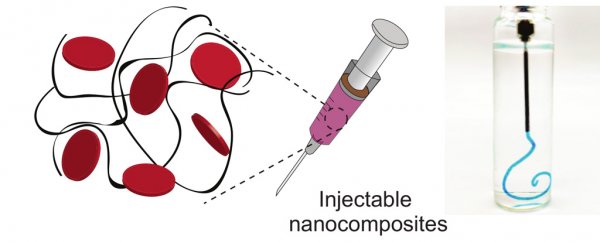Scientists have invented an injectable 'bandage' made out of a common food ingredient and nanoparticles. And not only does this material staunch bleeding stunningly fast, it also helps wounds heal more quickly.
When a person is wounded, they don't necessarily just bleed on the outside - gunshots and other injuries often cause internal bleeding as well, which needs to be dealt with as quickly as possible.
In recent years, scientists have been coming up with new kinds of materials that can quickly plug a wound - such as this incredible sponge-filled syringe - but getting that same effect deeper in the body has remained a challenge.
Now a team of biomedical engineers at Texas A&M University has invented a totally new 'injectable bandage'. It's comprised of a seaweed-derived gelling agent and two-dimensional clay nanoparticles.
Together, these unlikely ingredients form what's known as a hydrogel - highly absorbent, jelly-like substance with a super-high water content that can work remarkably well as wound dressing.
"Injectable hydrogels are promising materials for [..] internal injuries and bleeding, as these biomaterials can be introduced into a wound site using minimally invasive approaches," the team writes in the study.
The main substance in the team's injectable hydrogel is the gelatinous k-carrageenan, derived from red edible seaweed and found as a plant-based thickening agent in many foods.
In their previous work with gelatin, the researchers discovered that hydrogels can be boosted with the use of nanosilicates - tiny clay-based particles that improve the structure of the gel by forming a frame - effectively turning it into an 'injectable bandage'.
When the team tested their bandage on animal and human tissue cells in the lab, they watched the nanoparticle-infused hydrogel kick off blood clotting in less than three minutes.
"An ideal injectable bandage should solidify after injection in the wound area and promote a natural clotting cascade," explains biomedical engineer Akhilesh K. Gaharwar from Texas A&M.
On top of that, the team also noticed significantly improved tissue regeneration and wound healing in their treated lab samples. And, best of all, the nanoparticles used to make this hydrogel could also deliver medication to the wound site, slowly releasing it into the body as needed.
So far, the team's hydrogel hasn't been tested in human wounds, but its highly promising performance means it could only be a matter of time until doctors can add this injectable bandage to their arsenal.
The research has been published in Acta Biomaterialia.
